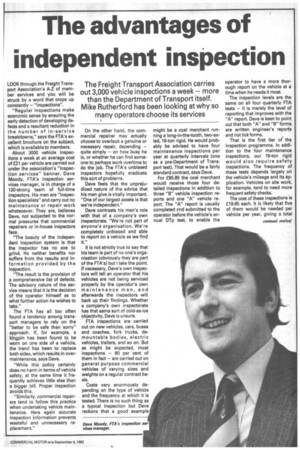The advantages of independent inspection
Page 39

If you've noticed an error in this article please click here to report it so we can fix it.
The Freight Transport Association carries out 3,000 vehicle inspections a week — more than the Department of Transport itself. Mike Rutherford has been looking at why so many operators choose its services
LOOK through the Freight Transport Association's A-Z of member services and you will be struck by a word that crops up constantly — "inspections".
"Regular inspections make economic sense by ensuring the early detection of developing defects and a resultant reduction in the number of in-service breakdowns," says the FTA's excellent brochure on the subject, which is available to members.
About 3000 vehicle inspections a week at an average cost of £21 per vehicle are carried out under the association's "inspection services" banner. Dave Moody, FTA's inspection services manager, is in charge of a 120-strong team of full-time inspectors. His men are "inspection specialists" and carry out no maintenance or repair work whatsoever. They are, believes Dave, not subjected to the normal pressures that commercial repairers or in-house inspectors face.
"The beauty of the independent inspection system is that the inspector has no axe to grind. He neither benefits nor suffers from the results and information provided by the inspection.
"The result is the provision of a comprehensive list of defects. The advisory nature of the service means that it is the decision of the operator himself as to what further action he wishes to take."
The FTA has all too often found a tendency among transport managers to rely on the "better to be safe than sorry" approach. If, for example, a kingpin has been found to be worn on one side of a vehicle, the trend has been to replace both sides, which results in overmaintenance, says Dave.
"While this policy certainly does no harm in terms of vehicle safety, at the same time it frequently achieves little else than a bigger bill. Proper inspection avoids this.
"Similarly, commercial repairers tend to follow this practice when undertaking vehicle maintenance. Here again accurate inspection information prevents wasteful and unnecessary replacement."
On the other hand, the commercial repairer may actually choose to overlook a genuine or necessary repair, depending — quite simply — on how busy he is, or whether he can find someone to perhaps work overtime to do the job. The FTA's unbiased inspectors hopefully eradicate this sort of problems.
Dave feels that the unprejudiced nature of the advice that his men give is vitally important. "One of our largest assets is that we're independent."
Dave contrasts his men's role with that of a company's own inspectorate. "We're not part of anyone's organisation. We're completely unbiased and able to report on a vehicle as we find it."
It is not strictly true to say that his team is part of no one's organisation (obviously they are part of the FTA's) but I take the point. If necessary, Dave's own inspectors will tell an operator that his vehicles are not being serviced properly by the operator's own maintenance men, and afterwards the inspectors will back up their findings. Whether a company's own inspectorate has that same sort of cold-as-ice objectivity, Dave is unsure.
FTA inspections are carried out on new vehicles, cars, buses and coaches, fork trucks, demountable bodies, electric vehicles, trailers, and so on. But as might be expected, most inspections — 80 per cent of them in fact — are carried out on general purpose commercial vehicles of varying sizes and weights on a regular contract basis.
Costs vary enormously depending on the type of vehicle and the frequency at which it is tested. There is no such thing as a typical inspection but Dave reckons that a good example
might be a coal merchant running a long-in-the-tooth, two-axled, 16-ton rigid. He would probably be advised to have four maintenance inspections per year at quarterly intervals (one as a pre-Department of Transport test). That would be a fairly standard contract, says Dave.
For £95.85 the coal merchant would receive those four detailed inspections in addition to three "B" vehicle inspection reports and one "A" vehicle report. The "A" report is usually completed end submitted to the operator before the vehicle's annual DTp test, to enable the operator to have a more thorough report on the vehicle at a time when he needs it most.
The inspection levels are the same on all four quarterly FTA tests — it is merely the level of reporting that improves with the "A" report. Dave is keen to point out that both "A" and "B" forms are written engineer's reports and not tick forms.
That is the first tier of the inspection programme. In addition to the four maintenance inspections, our 16-ton rigid would also require safety inspections. The frequency of these tests depends largely on the vehicle's mileage and its application. Vehicles on site work, for example, tend to need more frequent safety checks.
The cost of these inspections is £19.65 each. It is likely that five of them would be needed per vehicle per year, giving a total




















































